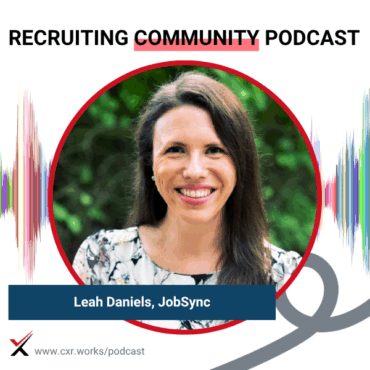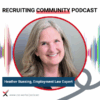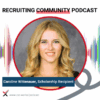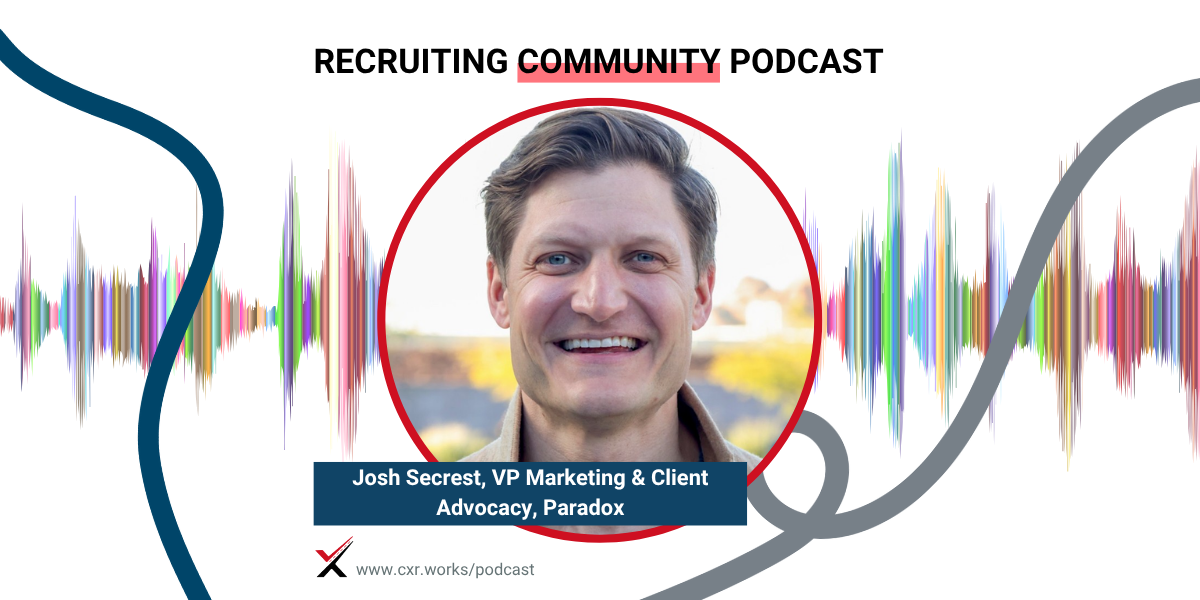
Trends to Watch for in 2025
What happens when AI tools help candidates apply to hundreds of jobs in seconds? We dive into the compliance mess, recruiter responses, and what’s next in 2025.
 play_arrow
play_arrow
Beyond ‘Don’t Do X’: Compliance as Problem-Solving Cami Grace
 play_arrow
play_arrow
Career Crossroads: A New Series from the CXR Team Cami Grace
 play_arrow
play_arrow
Agentic AI in Talent Acquisition: What Recruiters Need to Know and Plan For Cami Grace
 play_arrow
play_arrow
Russ Mountain Memorial Scholarship Spotlight with Caroline Wittenauer Cami Grace

Happy New Year! We’re kicking off 2025 with an engaging conversation featuring Josh Secrest, VP at Paradox and former Global Head of Talent Acquisition (TA) at McDonald’s. In this episode, we dive into how innovative TA leaders are redefining success by turning recruitment into a powerful revenue driver. From optimizing processes and leveraging automation to forming strategic partnerships with the C-suite, Josh shares actionable insights that can transform the way we think about talent acquisition.
We also explore game-changing trends, like automation’s impact on efficiency, the evolution of corporate hiring, and the critical need for TA leaders to master the art of building a business case. Plus, you’ll hear Josh’s perspective on where TA is headed in the next two years, including how segmentation and data-driven strategies are shaping the future. Tune in for inspiration, strategies, and practical takeaways to elevate your talent acquisition game!
[3:45] – Reflecting on 2024: Josh shares his journey from McDonald’s to Paradox and his passion for data-driven TA strategies.
[12:30] – The McDonald’s impact: How reducing hiring time from 21 days to 3 days drove revenue and streamlined operations.
[20:10] – The role of automation: Why scheduling tech has been a game-changer and how it’s reshaping the hiring process for high-volume and corporate roles.
[32:45] – Building partnerships with the C-suite: Tips on presenting TA as a critical revenue driver to CFOs and business leaders.
[40:00] – The future of TA: The rise of segmentation, quality-driven corporate hiring, and lessons from sports analytics.
[50:30] – Advice for TA leaders: Why understanding your team’s value proposition is key to securing budget approvals and driving innovation.
Thanks for listening to this episode of the CXR Podcast! If you enjoyed the conversation, don’t forget to subscribe, share, and leave a review on your favorite podcast platform. Let us know your thoughts in the comments, and we’ll see you next week for more talent acquisition insights!
Title:
Talent Acquisition as a Revenue Driver
Featured Guests:
Josh Secrest, Vice President, Paradox; Former Global Head of Talent Acquisition, McDonald’s
Hosts:
Chris Hoyt, President, CareerXroads
Gerry Crispin, Principal and Co-founder, CareerXroads
Episode Overview:
In this episode, the CXR team catches up with Josh Secrest to explore how automation is transforming talent acquisition across industries. Josh shares insights from his time leading global hiring at McDonald’s and his current role at Paradox, focusing on strategies for doing more with less, aligning TA with business outcomes, and leveraging automation to scale effectively. The discussion also touches on segmentation in hiring, ROI-driven decision-making, and emerging trends in scheduling and interview automation.
Key Topics:
Scaling hiring through automation at McDonald’s
ROI-focused TA strategies and financial alignment
Talent segmentation across distribution, frontline, and corporate roles
Adoption of automated scheduling and interview processes
Building a TA Ops function for metrics and process improvement
Budget challenges and confidence gaps among TA leaders
Future trends in professional hiring and quality focus
Notable Quotes:
“This costs $500K. Here’s how I’m saving $250K in media, $200K in process, and $50K in headcount.” — Josh Secrest
“We reduced hiring time from 21 days to 3 days, gave managers five hours back per restaurant, and saw big results.” — Josh Secrest
“Candidates apply to 15 jobs at once. The one that gets back to them first, with a confirmed interview, often wins.” — Josh Secrest
“You need to think like a CFO.” — Josh Secrest
“We’re done treating all jobs the same.” — Josh Secrest
Takeaways:
Josh Secrest highlights how aligning TA strategies with business outcomes—backed by automation and strong financial cases—can significantly improve hiring efficiency and impact. Leaders must embrace segmentation, prioritize speed and quality, and become fluent in ROI to navigate modern hiring challenges.
Want more conversations like this?
Subscribe to the CXR podcast and explore how top talent leaders are shaping the future of recruiting. Learn more about the CareerXroads community at cxr.works.
Chris Hoyt: All right, guys. It’s a new year. I’m super excited—we’re on, we’re live. Uh, welcome, welcome. Good to see you, Josh.
Josh Secrest: Oh my gosh. Good to see you, Chris. Good to see you, Jerry.
Chris Hoyt: Yeah.
Josh Secrest: Yeah.
Chris Hoyt: And happy New Year. Happy New Year. How long do we say “Happy New Year” for—about a week? Yeah, this is it. You get one week.
Gerry Crispin: Okay. The last day you can say “Happy New Year” is tomorrow. After that, you need to start something else.
Chris Hoyt: Yeah. Tomorrow all emails start with, “Hey, same stuff…” Can’t say the rest.
Did you guys make any big resolutions? Josh, did you put anything together for the year?
Josh Secrest: Mine is just to keep traveling. I got to see some cool parts of the world last year, and it really filled me up. I just want to keep the momentum going—getting more miles and seeing more things.
Chris Hoyt: I love it. Where did you go?
Josh Secrest: I got to see Japan for the first time—had the sushi trip of my life. Also did Australia and Barcelona. So it was a really cool trip around the world. Paradox made a lot of that possible, so I’m thankful.
Chris Hoyt: I love that. Well, Jerry’s taking a bit of a trip too. Mine is actually less travel this year…
Gerry Crispin: But the travel I do is still quite a bit. I’m taking my third oldest grandchild to Japan in March, and then I’m taking a delegation to Vietnam in the fall. We’ll be stopping by Paradox as part of that trip.
Chris Hoyt: Amazing. Jerry, I haven’t told you yet—we just decided this week. My nuclear family is going to do Thanksgiving in Japan.
Gerry Crispin: Wow.
Chris Hoyt: Yeah. My two daughters, their plus-ones, my new bride, and I—so six of us total. We’re doing Japan in November. I’m very excited to go back.
Gerry Crispin: You need to stay in touch with Hiromi on that for sure.
Chris Hoyt: Absolutely. I’ve got a picture—actually, it’s en route. It’s a quick snapshot of an alley in the middle of Tokyo. Just fascinating—the food, the culture, everything. Josh, if you’re going back to Japan, it’s like seeing a whole different world. Incredible.
Chris Hoyt: We also launched something fun this morning. If you’re on Strava and want to join us, we started a little club called TAIM—Talent Acquisition In Motion. Strava is free and you can connect it to other apps. I’ve got Tonal and Fitbit connected to mine.
We’re doing a simple challenge: a mile or at least 15 minutes of purposeful motion five days a week. Pretty easy. If you’re interested, go to strava.com/clubs/tateam. Anyone can join. Would golf count?
Gerry Crispin: Yeah, especially if you’re walking. You can get six miles that way.
Chris Hoyt: Why would you walk at golf?
Gerry Crispin: Well, I have one of those electric AI-type carts. You put your clubs in and it follows you around. Feels like you’re a professional golfer with a caddy.
Chris Hoyt: All right. Speaking of AI, we’ve got stuff to talk about. You guys ready?
Josh Secrest: Let’s do this.
Announcer: Welcome to the CXR channel, our premier podcast for talent acquisition and talent management. Listen in as the CXR community discusses a wide range of topics focused on attracting, engaging, and retaining the best talent. We’re glad you’re here.
Chris Hoyt: All right, what do you think, Jerry? New year—do we need a new intro?
Gerry Crispin: I’d like to see one. One where I at least know what my name is. Maybe even a picture. Who knows?
Chris Hoyt: Welcome to the Recruiting Community Podcast. It’s 2025, and we’re heading into the new year with a mix of the familiar and the fresh—weekly insights and updates in the form of conversations.
Today, we’ve got Josh Secrest, former Global Head of TA at McDonald’s and current VP at Paradox. We’re going to talk about how innovative TA leaders are doing a lot more with a lot less—everyone’s favorite mission statement, right?
We’re streaming live on YouTube, Facebook, LinkedIn, and Twitch. You can catch past and future episodes at cxr.org/podcast. If you’re with us on LinkedIn, say hi in the chat, introduce yourself, and drop your questions for Josh, Jerry, or me—we’re happy to answer.
Now, let’s welcome back Josh and put him in the big window. Welcome back, Josh!
Josh Secrest: Hi guys! Good to see you.
Chris Hoyt: This is fun. You were Head of TA at Abercrombie—that was your entry into TA, right? I think you were in HR as a business partner before that. I met you when you became Head of Global TA at McDonald’s. Then you moved to Paradox as VP of Marketing and Client Advocacy, and that was in 2021?
Josh Secrest: Correct. I had an awesome run with different roles. I joined Abercrombie on the business side to make t-shirts and run product. What was supposed to be a one-year stint in HR really stuck—I loved the business side of HR.
Then came the McDonald’s opportunity, which was super exciting. I’m passionate about HR and talent, and how it can drive business. TA was a neat place to explore that.
At McDonald’s, an understaffed restaurant directly cost us money. We could actually calculate it—being short one person meant slower ticket times and hundreds of dollars lost daily. So hiring faster and better actually turned TA into a revenue-driving function.
Paradox was our partner at McDonald’s. I fell in love with the tech, their innovation focus, and honestly, the people. Now I get to work with companies where TA leaders are becoming more strategic—driving revenue, finding cost savings, and leading innovation.
Chris Hoyt: Outside of bringing in tech or solution partners, what strategies have you found most effective for achieving significant results with fewer resources?
Josh Secrest: Honestly, in this era, automation has been the biggest disruptor in TA budgets. It’s not just a cool innovation—it’s reshaped how we work.
If we split TA into buckets: Distribution centers are fully automated now compared to five years ago. High-volume frontline hiring is 95% automated—going from 21 days to hire down to two or three days. The corporate side is seeing 30–40% efficiency gains—interview scheduling and onboarding are being streamlined.
So yeah, automation is a huge part. But also:
Team: Hire people with high potential who can scale their output and even grow into leadership.
Operations: I’m obsessed with process. We built a TA operations team that focused on reporting, tool optimization, and constant improvement. That investment paid off.
Gerry Crispin: What’s key to me is linking TA work to the company’s bottom line. At McDonald’s, you didn’t just look at hiring costs—you looked at the cost of being understaffed and how it impacted revenue. TA has to make that connection: who are we hiring, what do they do, and how does that affect profit? That takes more strategic thinking.
Chris Hoyt: Right. And it ties into a bigger discussion—how can TA better partner with the C-suite? Josh, you mentioned presenting numbers to the CFO. Not all TA leaders have that relationship or visibility to make that kind of impact.
Josh Secrest: That CFO relationship was one of my favorites. It changed how I thought about tech and budgeting.
McDonald’s was all about speed. Faster hiring meant customers got their food quicker and managers got time back. But on the corporate side, speed isn’t always the goal. You want the best Chief Marketing Officer, even if it takes 40 extra days.
Chris Hoyt: That scales down too—some roles need speed, some need quality.
Josh Secrest: Exactly. And if you can talk to your CFO in those terms, it opens up doors. We sponsored a report with Madeline Laurano at Aptitude Research—it looks at what TA leaders are facing in 2025. A few data points stood out:
64% of TA leaders say their budgets are going down.
33% feel like their current budget is being wasted.
62% don’t feel confident building a business case to ask for more budget.
That’s a problem.
Chris Hoyt: Yeah, that’s an eye-opener. If you can’t even ask for what you need…
Josh Secrest: Right. And the biggest mistake? Asking for new money instead of reallocating what you already have. A winning tactic is saying, “I’m cutting $100K from job ads and using it to pay for this $100K solution.” Now you’re not competing against every other department’s budget requests.
Chris Hoyt: That’s a game changer. And speaking of game changers—would you agree the biggest disruption in TA recently has been interview scheduling?
Josh Secrest: 100%. Especially in frontline hiring. Candidates apply to 15 jobs at once. Whoever gets back to them first usually wins.
At 3 a.m., someone applies and instantly gets a message: “Hey Jerry, we’d love to see you. Can you come in tomorrow morning?” That’s powerful.
Gerry Crispin: That tech will be huge for corporate roles too. We just need better data collection and interview automation at the top of the funnel.
Josh Secrest: The scheduling tech is so sophisticated now. You can do group interviews, international scheduling, exec coordination—it takes a ton off recruiters’ plates and frees up time for human connection.
Chris Hoyt: So what’s next? What trend will define TA resource optimization in the next couple of years?
Josh Secrest: I think segmentation is key. Stop treating all recruiting the same. Distribution centers, retail, university, corporate—they all need different approaches.
Also, I think corporate hiring is going to get more sophisticated. We’ll take our time, do more projects, and really invest in finding the best person for those high-impact roles.
Gerry Crispin: Totally agree. We also need to automate how we collect top-of-funnel data. Resumes all look the same now, especially with candidates using AI. We need new ways to assess skills and potential.
Chris Hoyt: It’ll come down to leadership and strategy. Hopefully we use the time we’ve saved to focus more on meaningful hiring, not just cramming more work in.
Josh Secrest: Exactly. And if you can show how hiring the right person can impact millions in revenue, it’s worth taking a little more time to get it right.
Chris Hoyt: Josh, before we let you go—if you were going to write a book about this topic, what would the title be?
Josh Secrest: Oh man… I think something like “Moneyball for HR.” I don’t follow sports closely, but I love reading about how teams use data to build winning rosters. I think HR can learn a lot from that model.
Chris Hoyt: Love it. Who gets the first signed copy?
Josh Secrest: My mentor Jim Bauer from Abercrombie. He got me hooked on the business side of HR and data.
Chris Hoyt: I love that. Josh, thanks so much for your time. We’ll drop the link to the report in the post. Everybody else—head to cxr.org/podcast to catch the next one. Thanks again, Josh!
Josh Secrest: Thanks, guys!
Announcer: Thanks for listening to the CXR channel. Please subscribe on your favorite podcast platform and leave us a review. Learn more at cxr.works and follow us on social media @CareerXroads. We’ll catch you next time.
Tagged as: Talent Acquisition, high-volume hiring, Candidate Experience, Scheduling Automation, paradox, ROI, Employer Branding.
Chris Hoyt is the President of CareerXroads, a global peer community for talent acquisition leaders driving strategic change. With decades of experience leading recruiting innovation at Fortune 500 companies, Chris now advises enterprise TA teams on tech, process, and leadership. He’s a frequent speaker at conferences like SHRM, HR Tech, LinkedIn, and UNLEASH, and he’s known for pushing conversations beyond buzzwords to get to what really works in hiring. Through CXR, he connects top TA professionals to solve real problems, challenge norms, and shape the future of recruiting.

What happens when AI tools help candidates apply to hundreds of jobs in seconds? We dive into the compliance mess, recruiter responses, and what’s next in 2025.

